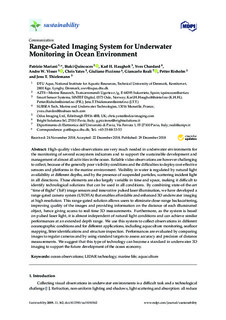| dc.description.abstract | High-quality video observations are very much needed in underwater environments for the monitoring of several ecosystem indicators and to support the sustainable development and management of almost all activities in the ocean. Reliable video observations are however challenging to collect, because of the generally poor visibility conditions and the difficulties to deploy cost-effective sensors and platforms in the marine environment. Visibility in water is regulated by natural light availability at different depths, and by the presence of suspended particles, scattering incident light in all directions. Those elements are also largely variable in time and space, making it difficult to identify technological solutions that can be used in all conditions. By combining state-of-the-art “time of flight” (ToF) image sensors and innovative pulsed laser illumination, we have developed a range-gated camera system (UTOFIA) that enables affordable and enhanced 3D underwater imaging at high resolution. This range-gated solution allows users to eliminate close-range backscattering, improving quality of the images and providing information on the distance of each illuminated object, hence giving access to real-time 3D measurements. Furthermore, as the system is based on pulsed laser light, it is almost independent of natural light conditions and can achieve similar performances at an extended depth range. We use this system to collect observations in different oceanographic conditions and for different applications, including aquaculture monitoring, seafloor mapping, litter identifications and structure inspection. Performances are evaluated by comparing images to regular cameras and by using standard targets to assess accuracy and precision of distance measurements. We suggest that this type of technology can become a standard in underwater 3D imaging to support the future development of the ocean economy | nb_NO |

